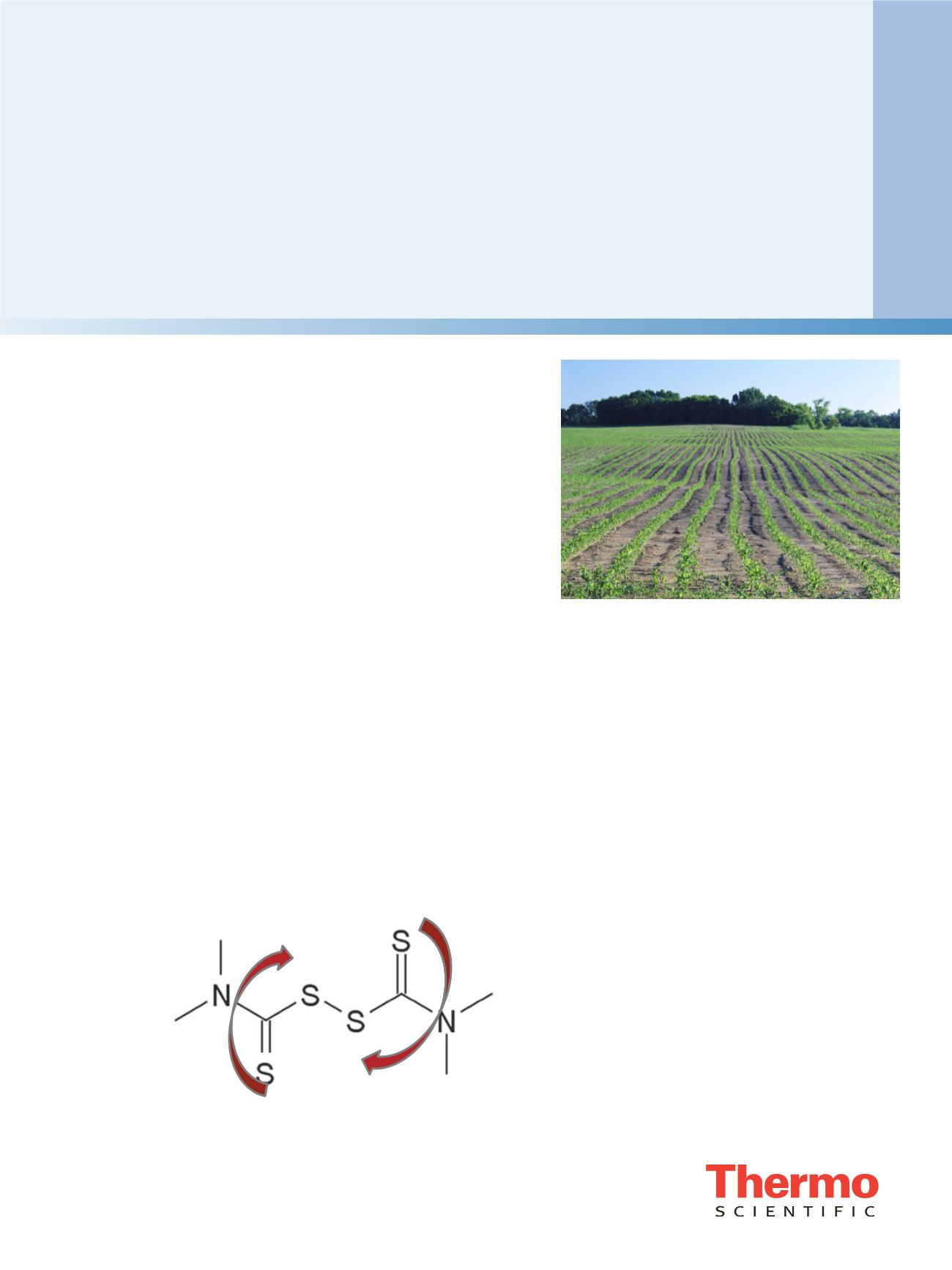

Technical Support Note-000
Analysis of Dithiocarbamate Pesticides by
GC-MS
Soma Dasgupta
1,2
, Sumaiyya Mujawar
1
, Kaushik Banerjee
1
, Hans-Joachim Huebschmann
3
1
National Research Center for Grapes, Pune, India,
2
Thermo Fisher Scientific, Mumbai, India,
3
Thermo Fisher Scientific, Singapore
Introduction
The class of dithiocarbamate fungicides (DTCs) is widely
used in agriculture. They are non-systemic and both the
formulation and their break-down products typically
remain at the site of application. DTCs are characterized
by a broad spectrum of activity against various plant
pathogens, low acute mammal toxicity, and low
production costs
[1]
. The dithiocarbamate moiety is highly
reactive: it readily chelates most heavy metals, reacts with
sulfhydryl groups of proteins, rendering itself neurotoxic,
teratogenic, and cytotoxic.
DTCs are not stable and cannot be extracted or analyzed
directly. Contact with acidic plant juices degrades
DTCs rapidly and they decompose into carbon disulfide
(CS
2
) and the respective amine
[1]
. It is not possible to
homogenize plant samples and extract DTCs by organic
solvents, as it is, for instance, with the QuEChERS
standard procedure in pesticide-residue analyses.
Maximum residue levels (MRLs) of DTCs are generally
expressed as mg CS
2
/kg food.
Dithiocarbamates can be quantitatively converted to
carbon disulphide by reaction with tin(II)chloride in
aqueous HCl (1 : 1) in a closed bottle at 80 ˚C. The CS
2
gas
produced is absorbed into iso-octane and measured by
GC-MS. The analysis of DTCs for this application follows
the acid-hydrolysis method using SnCl
2
/HCl
[2]
. For
method validation of the DTC pesticides, Thiram (99.5%
purity) was used as representative bis (dithiocarbamate)
compound considering its simple structure (1 mole of
Thiram = 2 mole of CS
2
=>1 mg of Thiram theoretically
generates 0.6333 mg CS
2
, 1 mL of 100 ppm Thiram
in 25 g of grapes = 2.5 ppm of CS
2
); see Figure 1. The
total DTC residues were estimated by analysing CS
2
as
the DTC hydrolysis products by GC-MS. This is a non-
specific DTC sum method that does not distinguish
between the different species of DTCs in the sample.
Interferences are known from natural precursors e.g. from
crops or brassica, that can produce CS
2
as well during the
hydrolysis
[1, 2]
.
Sample Preparation
A previously reported SnCl
2
/HCl acid-hydrolysis method
was employed for sample preparation
[3]
. The described
method follows the established methods applied in the EU
reference laboratories and European commercial testing
laboratories for CS
2
analysis. From the homogenized
sample, 25 g are taken in a 250 mL glass bottle, 75 mL
of the reaction mixture is added, followed by 25 mL iso-
Keywords:
Food safety, Dithiocarbamate fungicides, DTCs, Hydrolysis,
Thiram, GC-MS, SIM
Application No e 10333
Figure 1. Thiram - 1 mole of Thiram generates 2 mole of CS
2
.



















